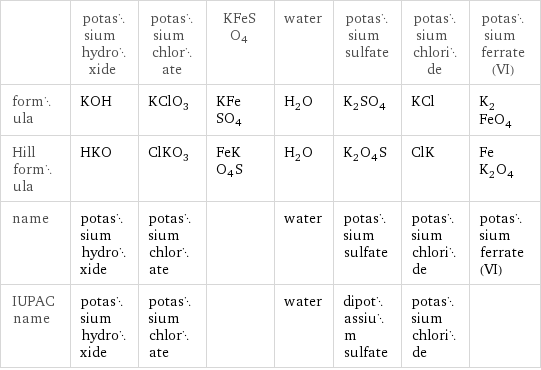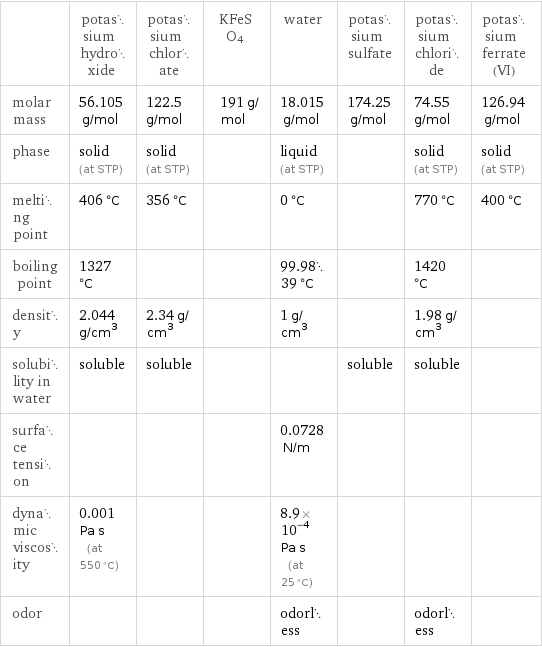Input interpretation

KOH potassium hydroxide + KClO_3 potassium chlorate + KFeSO4 ⟶ H_2O water + K_2SO_4 potassium sulfate + KCl potassium chloride + K_2FeO_4 potassium ferrate(VI)
Balanced equation

Balance the chemical equation algebraically: KOH + KClO_3 + KFeSO4 ⟶ H_2O + K_2SO_4 + KCl + K_2FeO_4 Add stoichiometric coefficients, c_i, to the reactants and products: c_1 KOH + c_2 KClO_3 + c_3 KFeSO4 ⟶ c_4 H_2O + c_5 K_2SO_4 + c_6 KCl + c_7 K_2FeO_4 Set the number of atoms in the reactants equal to the number of atoms in the products for H, K, O, Cl, Fe and S: H: | c_1 = 2 c_4 K: | c_1 + c_2 + c_3 = 2 c_5 + c_6 + c_7 O: | c_1 + 3 c_2 + 4 c_3 = c_4 + 4 c_5 + 2 c_7 Cl: | c_2 = c_6 Fe: | c_3 = c_7 S: | c_3 = c_5 Since the coefficients are relative quantities and underdetermined, choose a coefficient to set arbitrarily. To keep the coefficients small, the arbitrary value is ordinarily one. For instance, set c_2 = 1 and solve the system of equations for the remaining coefficients: c_1 = 6 c_2 = 1 c_3 = 3 c_4 = 3 c_5 = 3 c_6 = 1 c_7 = 3 Substitute the coefficients into the chemical reaction to obtain the balanced equation: Answer: | | 6 KOH + KClO_3 + 3 KFeSO4 ⟶ 3 H_2O + 3 K_2SO_4 + KCl + 3 K_2FeO_4
Structures

+ + KFeSO4 ⟶ + + +
Names

potassium hydroxide + potassium chlorate + KFeSO4 ⟶ water + potassium sulfate + potassium chloride + potassium ferrate(VI)
Equilibrium constant
![K_c = ([H2O]^3 [K2SO4]^3 [KCl] [K2FeO4]^3)/([KOH]^6 [KClO3] [KFeSO4]^3)](../image_source/4c0fd0cd9a102a98daf1fd7f6a49d327.png)
K_c = ([H2O]^3 [K2SO4]^3 [KCl] [K2FeO4]^3)/([KOH]^6 [KClO3] [KFeSO4]^3)
Rate of reaction
![rate = -1/6 (Δ[KOH])/(Δt) = -(Δ[KClO3])/(Δt) = -1/3 (Δ[KFeSO4])/(Δt) = 1/3 (Δ[H2O])/(Δt) = 1/3 (Δ[K2SO4])/(Δt) = (Δ[KCl])/(Δt) = 1/3 (Δ[K2FeO4])/(Δt) (assuming constant volume and no accumulation of intermediates or side products)](../image_source/6964a5f92feae7a341e21ee488d2240c.png)
rate = -1/6 (Δ[KOH])/(Δt) = -(Δ[KClO3])/(Δt) = -1/3 (Δ[KFeSO4])/(Δt) = 1/3 (Δ[H2O])/(Δt) = 1/3 (Δ[K2SO4])/(Δt) = (Δ[KCl])/(Δt) = 1/3 (Δ[K2FeO4])/(Δt) (assuming constant volume and no accumulation of intermediates or side products)
Chemical names and formulas

| potassium hydroxide | potassium chlorate | KFeSO4 | water | potassium sulfate | potassium chloride | potassium ferrate(VI) formula | KOH | KClO_3 | KFeSO4 | H_2O | K_2SO_4 | KCl | K_2FeO_4 Hill formula | HKO | ClKO_3 | FeKO4S | H_2O | K_2O_4S | ClK | FeK_2O_4 name | potassium hydroxide | potassium chlorate | | water | potassium sulfate | potassium chloride | potassium ferrate(VI) IUPAC name | potassium hydroxide | potassium chlorate | | water | dipotassium sulfate | potassium chloride |
Substance properties

| potassium hydroxide | potassium chlorate | KFeSO4 | water | potassium sulfate | potassium chloride | potassium ferrate(VI) molar mass | 56.105 g/mol | 122.5 g/mol | 191 g/mol | 18.015 g/mol | 174.25 g/mol | 74.55 g/mol | 126.94 g/mol phase | solid (at STP) | solid (at STP) | | liquid (at STP) | | solid (at STP) | solid (at STP) melting point | 406 °C | 356 °C | | 0 °C | | 770 °C | 400 °C boiling point | 1327 °C | | | 99.9839 °C | | 1420 °C | density | 2.044 g/cm^3 | 2.34 g/cm^3 | | 1 g/cm^3 | | 1.98 g/cm^3 | solubility in water | soluble | soluble | | | soluble | soluble | surface tension | | | | 0.0728 N/m | | | dynamic viscosity | 0.001 Pa s (at 550 °C) | | | 8.9×10^-4 Pa s (at 25 °C) | | | odor | | | | odorless | | odorless |
Units
